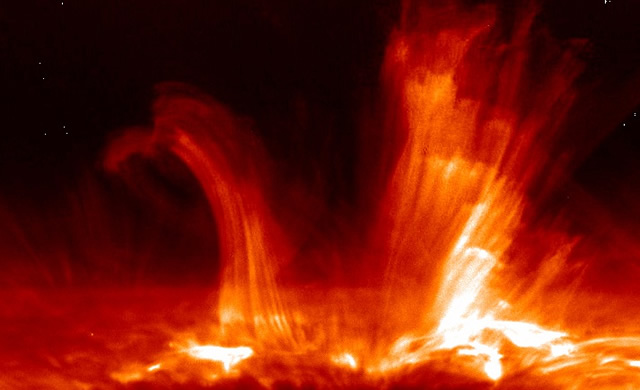
IRIS osserverà da vicino la parte più bassa dell’atmosfera del sole, laddove si producono spettacolari brillamenti come quello in questa foto.
IRIS will take a closer look at the lower parts of the sun’s atmosphere, which is producing the spectacular flare shown in this image. Credit: NASA&JAXA/Hinode
Come funziona il flusso di energia del sole? Nonostante il fatto che noi viviamo relativamente vicino, a 93 milioni di miglia, o a otto minuti luce, dalla nostra stella, e che vi sono al momento diversi veicoli spaziali in osservazione costante in orbita intorno a lei, si sa ancora poco sui trasferimenti di energia e le loro dinamiche, attraverso l’atmosfera solare.
L’ultima missione solare della NASA è incentrata sulla necessità di capire di più sul funzionamento dell’attività solare. Si chiama Interface Region Imaging Spectrograph (IRIS), e sarà posizionato su un posto nella bassa atmosfera del sole conosciuto come “regione di interfaccia.” La zona ha solo uno spessore di circa 3.000 – 6.000 miglia ed è visto come il punto di trasferimento chiave per quanto riguarda la corona incredibilmente calda del sole (zona visibile durante le eclissi solari totali.) “IRIS estenderà le nostre osservazioni del sole di una regione che è stata storicamente difficile da studiare “, ha dichiarato Joe Davila, scienziato del progetto IRIS del Goddard Space Flight Center della NASA. “Capire la regione di interfaccia solare migliorerà la nostra comprensione di tutta la corona e, a sua volta, come influisce sul sistema solare.” Capire di più la regione di interfaccia, la NASA ha affermato, ci insegnerà molto di più sulla “meteorologia spaziale” che colpisce la Terra.
How does the sun’s energy flow? Despite the fact that we live relatively close (93 million miles, or eight light-minutes) to this star, and that we have several spacecraft peering at it, we still know little about how energy transfers through the solar atmosphere.
NASA’s next solar mission will launch Wednesday, June 26 (if all goes to plan) to try to learn a little bit more. It’s called the Interface Region Imaging Spectrograph (IRIS), and it will zero in on a spot in the sun’s lower atmosphere known as the “interface region.” The zone only has a thickness of 3,000 to 6,000 miles and is seen as a key transfer point to the sun’s incredibly hot corona (that you can see during total solar eclipses.) “IRIS will extend our observations of the sun to a region that has historically been difficult to study,” stated Joe Davila, IRIS project scientist at NASA’s Goddard Space Flight Center. “Understanding the interface region better improves our understanding of the whole corona and, in turn, how it affects the solar system.” Figuring out more about the interface region, NASA stated, will teach us a lot more about the “space weather” that affects Earth.
Source/Continue reading → Phys.org





















